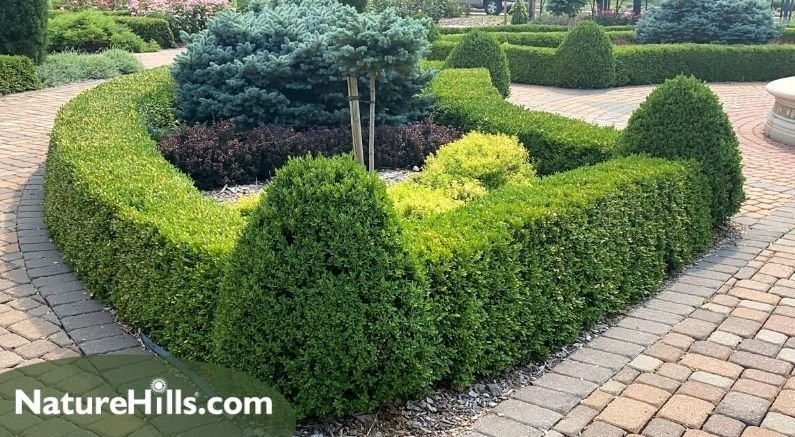The Complete Guide To Creating Boxwood Hedges
Good fences make good neighbors, and Boxwood hedges create the perfect natural fence! These versatile evergreen shrubs offer lush green foliage, consistent growth, and compact form, making them ideal for both formal and informal landscaping.
While there are many types of shrubs for hedges available, the iconic Boxwood stands out with consistent growth, lush green foliage, plus compact growth!
Why Choose Boxwood For Hedging?
Boxwood varieties have been garden favorites since 4,000 BC in Roman villa gardens. Here's why they're perfect for modern landscapes:
- Deer and rabbit resistant - plant without worry
- Year-round green color - beautiful in all seasons
- Low maintenance - easy to trim and maintain
- Versatile styling - formal hedges, informal borders, or topiary shapes
Planning Your Boxwood Hedge
Site Preparation
- Mark your layout using a garden hose, stakes, and twine, or marking paint
- Test your soil - ensure proper pH and drainage for Boxwood (6.5 to 7.5)
- Dig proper holes - twice the root system size for good drainage
- Install drip irrigation - essential for first-year establishment
- Add arborist mulch - 3-4 inches for weed control and moisture retention
Pro Tip: Boxwood has shallow roots and dislikes wet soil. If drainage is poor, create a berm to elevate your hedge.
Boxwood Hedge Styles
Formal Hedges
Perfect for a refined, castle-like appearance. Plant uniformly in straight rows and trim regularly for a solid green wall.
Informal Hedges
Create a cottage garden feel with natural shapes. Space plants wider apart and enjoy early spring white flowers when left unpruned. Use curved or zigzag lines instead of straight rows.
Other Landscaping Uses For Boxwoods
Add visual interest by placing taller shrubs at key locations:

- Foundation plantings
- Anchor corners or hedge ends
- Flank driveways and walkways
- Create focal points with groupings
- Frame seating areas for privacy
- Add definition to garden spaces
- Garden backdrops and property division
- Knot gardens and Formal hedges
Best Boxwood Varieties For Hedges
Small Hedges (Under 3 feet)
- Dwarf English Boxwood: 18-24" mature size
- Formal: 12" spacing | Informal: 24-30" spacing
- Green Gem Boxwood: 2-3 feet mature size
- Formal: 15-18" spacing | Informal: 30" spacing
Medium Hedges (3-4 feet)
- Green Velvet Boxwood: 3-4 feet (most popular variety)
- Formal: 15-18" spacing | Natural: 3-4 feet spacing
- Wintergreen Boxwood: 4-5 feet spread
- Formal: 24" spacing | Informal: 3-4 feet spacing
Tall Hedges (4+ feet)
- Green Mountain Boxwood: 5 feet tall, 3 feet wide (pyramidal shape)
- Formal: 18" spacing | Informal: 30"+ spacing
Boxwood Spacing Guide
- Closer spacing = faster results, but more plants are needed.
- Wider spacing = fewer plants needed, but longer to fill in
Remember: mature spread determines plant quantity, while height is easily controlled through pruning.
Pruning Your Boxwood Hedge
- Hand pruners: Create a soft, informal look
- Electric/gas shears: Best for a formal, even appearance
- Timing: Avoid late summer/fall pruning - allow new growth to harden before winter
- Shape: Trim wider at the bottom, narrower at the top for full coverage and to allow light penetration into the lower branches and prevent them from being shaded out.
Preventing Boxwood Blight
Boxwood blight is a fungal disease (Calonectria pseudonaviculata) that can damage your hedge. Watch for these symptoms:
Early Signs:
- Dark leaf spots that become brown blotches
- White fungal spores under leaves (in humid conditions)
- Rapid leaf loss from bottom to top
Advanced Symptoms:
- Black streaks (cankers) on green stems
- White fuzzy fungal masses during high humidity
Action Plan: Remove infected plants immediately and protect nearby plants from spread.
For detailed information, visit Purdue University's resources.
Benefits of Boxwood Hedges
- Privacy screening - a natural barrier for seclusion
- Sound dampening - reduces noise from busy roads
- Wind protection - blocks harsh winds
- Wildlife habitat - provides shelter for local birds
- Year-round interest - green backdrop for seasonal plants
Bring on the Boxwoods!
Ready to plant your Boxwood hedge? Head over to our Garden Blog for caring tips, then browse our Boxwood selection at NatureHills.com to find the perfect variety for your landscape.
Transform your property with the timeless beauty of Boxwood hedges - your neighbors will be impressed with your natural "good fence"!
Happy Planting!


